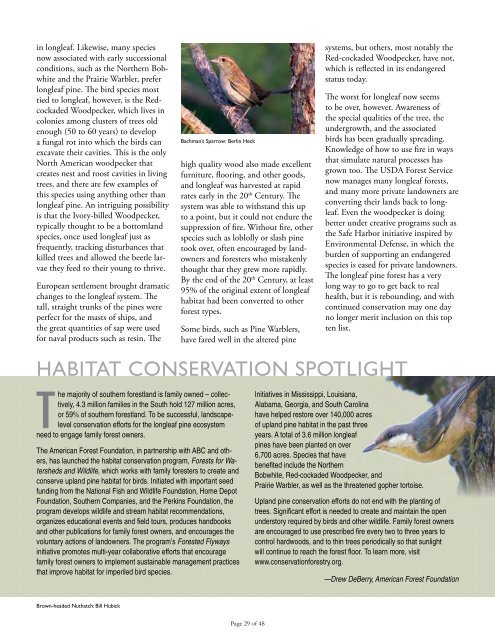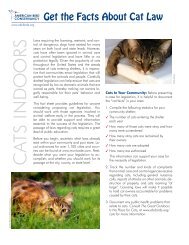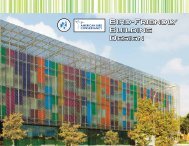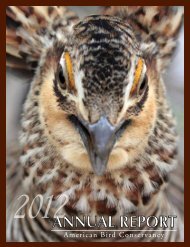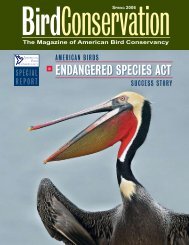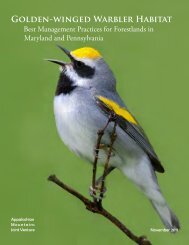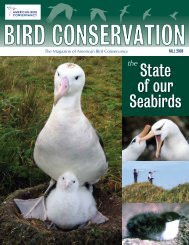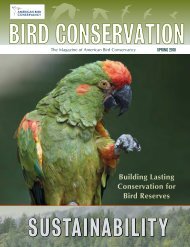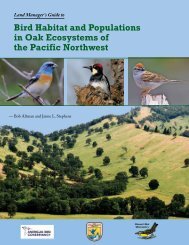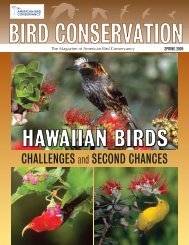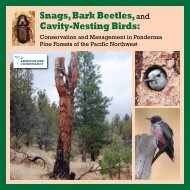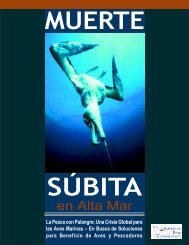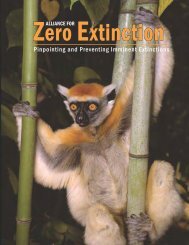Top 20 Most Threatened Bird Habitats in the U.S. - American Bird ...
Top 20 Most Threatened Bird Habitats in the U.S. - American Bird ...
Top 20 Most Threatened Bird Habitats in the U.S. - American Bird ...
You also want an ePaper? Increase the reach of your titles
YUMPU automatically turns print PDFs into web optimized ePapers that Google loves.
<strong>in</strong> longleaf. Likewise, many speciesnow associated with early successionalconditions, such as <strong>the</strong> Nor<strong>the</strong>rn Bobwhiteand <strong>the</strong> Prairie Warbler, preferlongleaf p<strong>in</strong>e. The bird species mosttied to longleaf, however, is <strong>the</strong> RedcockadedWoodpecker, which lives <strong>in</strong>colonies among clusters of trees oldenough (50 to 60 years) to developa fungal rot <strong>in</strong>to which <strong>the</strong> birds canexcavate <strong>the</strong>ir cavities. This is <strong>the</strong> onlyNorth <strong>American</strong> woodpecker thatcreates nest and roost cavities <strong>in</strong> liv<strong>in</strong>gtrees, and <strong>the</strong>re are few examples ofthis species us<strong>in</strong>g anyth<strong>in</strong>g o<strong>the</strong>r thanlongleaf p<strong>in</strong>e. An <strong>in</strong>trigu<strong>in</strong>g possibilityis that <strong>the</strong> Ivory-billed Woodpecker,typically thought to be a bottomlandspecies, once used longleaf just asfrequently, track<strong>in</strong>g disturbances thatkilled trees and allowed <strong>the</strong> beetle larvae<strong>the</strong>y feed to <strong>the</strong>ir young to thrive.European settlement brought dramaticchanges to <strong>the</strong> longleaf system. Thetall, straight trunks of <strong>the</strong> p<strong>in</strong>es wereperfect for <strong>the</strong> masts of ships, and<strong>the</strong> great quantities of sap were usedfor naval products such as res<strong>in</strong>. TheBachman’s Sparrow: Berl<strong>in</strong> Heckhigh quality wood also made excellentfurniture, floor<strong>in</strong>g, and o<strong>the</strong>r goods,and longleaf was harvested at rapidrates early <strong>in</strong> <strong>the</strong> <strong>20</strong> th Century. Thesystem was able to withstand this upto a po<strong>in</strong>t, but it could not endure <strong>the</strong>suppression of fire. Without fire, o<strong>the</strong>rspecies such as loblolly or slash p<strong>in</strong>etook over, often encouraged by landownersand foresters who mistakenlythought that <strong>the</strong>y grew more rapidly.By <strong>the</strong> end of <strong>the</strong> <strong>20</strong> th Century, at least95% of <strong>the</strong> orig<strong>in</strong>al extent of longleafhabitat had been converted to o<strong>the</strong>rforest types.Some birds, such as P<strong>in</strong>e Warblers,have fared well <strong>in</strong> <strong>the</strong> altered p<strong>in</strong>esystems, but o<strong>the</strong>rs, most notably <strong>the</strong>Red-cockaded Woodpecker, have not,which is reflected <strong>in</strong> its endangeredstatus today.The worst for longleaf now seemsto be over, however. Awareness of<strong>the</strong> special qualities of <strong>the</strong> tree, <strong>the</strong>undergrowth, and <strong>the</strong> associatedbirds has been gradually spread<strong>in</strong>g.Knowledge of how to use fire <strong>in</strong> waysthat simulate natural processes hasgrown too. The USDA Forest Servicenow manages many longleaf forests,and many more private landowners areconvert<strong>in</strong>g <strong>the</strong>ir lands back to longleaf.Even <strong>the</strong> woodpecker is do<strong>in</strong>gbetter under creative programs such as<strong>the</strong> Safe Harbor <strong>in</strong>itiative <strong>in</strong>spired byEnvironmental Defense, <strong>in</strong> which <strong>the</strong>burden of support<strong>in</strong>g an endangeredspecies is eased for private landowners.The longleaf p<strong>in</strong>e forest has a verylong way to go to get back to realhealth, but it is rebound<strong>in</strong>g, and withcont<strong>in</strong>ued conservation may one dayno longer merit <strong>in</strong>clusion on this topten list.HABITAT CONSERVATION SPOTLIGHTThe majority of sou<strong>the</strong>rn forestland is family owned – collectively,4.3 million families <strong>in</strong> <strong>the</strong> South hold 127 million acres,or 59% of sou<strong>the</strong>rn forestland. To be successful, landscapelevelconservation efforts for <strong>the</strong> longleaf p<strong>in</strong>e ecosystemneed to engage family forest owners.The <strong>American</strong> Forest Foundation, <strong>in</strong> partnership with ABC and o<strong>the</strong>rs,has launched <strong>the</strong> habitat conservation program, Forests for Watershedsand Wildlife, which works with family foresters to create andconserve upland p<strong>in</strong>e habitat for birds. Initiated with important seedfund<strong>in</strong>g from <strong>the</strong> National Fish and Wildlife Foundation, Home DepotFoundation, Sou<strong>the</strong>rn Companies, and <strong>the</strong> Perk<strong>in</strong>s Foundation, <strong>the</strong>program develops wildlife and stream habitat recommendations,organizes educational events and field tours, produces handbooksand o<strong>the</strong>r publications for family forest owners, and encourages <strong>the</strong>voluntary actions of landowners. The program’s Forested Flyways<strong>in</strong>itiative promotes multi-year collaborative efforts that encouragefamily forest owners to implement susta<strong>in</strong>able management practicesthat improve habitat for imperiled bird species.Initiatives <strong>in</strong> Mississippi, Louisiana,Alabama, Georgia, and South Carol<strong>in</strong>ahave helped restore over 140,000 acresof upland p<strong>in</strong>e habitat <strong>in</strong> <strong>the</strong> past threeyears. A total of 3.6 million longleafp<strong>in</strong>es have been planted on over6,700 acres. Species that havebenefited <strong>in</strong>clude <strong>the</strong> Nor<strong>the</strong>rnBobwhite, Red-cockaded Woodpecker, andPrairie Warbler, as well as <strong>the</strong> threatened gopher tortoise.Upland p<strong>in</strong>e conservation efforts do not end with <strong>the</strong> plant<strong>in</strong>g oftrees. Significant effort is needed to create and ma<strong>in</strong>ta<strong>in</strong> <strong>the</strong> openunderstory required by birds and o<strong>the</strong>r wildlife. Family forest ownersare encouraged to use prescribed fire every two to three years tocontrol hardwoods, and to th<strong>in</strong> trees periodically so that sunlightwill cont<strong>in</strong>ue to reach <strong>the</strong> forest floor. To learn more, visitwww.conservationforestry.org.—Drew DeBerry, <strong>American</strong> Forest FoundationBrown-headed Nuthatch: Bill HubickPage 29 of 48


